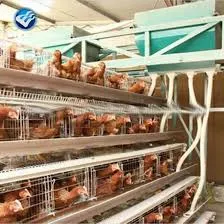Layer Hen Farming in Battery Cages for Optimal Egg Production and Welfare Practices
Nov . 07, 2024 23:18 Back to list
Layer Hen Farming in Battery Cages for Optimal Egg Production and Welfare Practices
The Pros and Cons of Layer Chicken Battery Cages
The poultry industry has long been a cornerstone of agricultural production, supplying millions with a reliable source of protein and other essential nutrients. Among the various practices utilized in chicken farming, layer chicken battery cages have garnered both support and criticism. These cages are a common housing system for egg-laying hens, designed to maximize space and production efficiency. However, as concerns about animal welfare and sustainability continue to grow, it's crucial to examine both the benefits and drawbacks of this method.
Understanding Layer Chicken Battery Cages
Layer chicken battery cages are small enclosures that typically house multiple hens in close quarters. These cages are often stacked in rows, allowing farmers to maximize the number of birds per square foot of space. While this system can increase productivity and make it easier for farmers to manage their flocks, it raises significant ethical questions regarding the treatment of the animals confined within these structures.
Advantages of Battery Cages
One of the primary advantages of battery cages is their efficiency. Farmers can produce a large quantity of eggs with relatively low investment costs. This high-volume production is particularly important in a world where the demand for eggs continues to rise. Additionally, battery cages simplify the management of flocks, as they allow for automated feeding and egg collection processes, reducing labor costs and improving overall productivity.
From a biosecurity perspective, layer chicken battery cages also offer advantages. The confinement of hens in these cages limits their exposure to diseases that can spread through larger populations. This can be particularly important in mitigating outbreaks of avian flu and other diseases that can decimate poultry stocks.
layer chicken battery cage

Criticism and Animal Welfare Concerns
Despite the advantages, battery cages have faced considerable criticism, especially from animal welfare advocates. Critics argue that the confinement of hens in small spaces restricts their natural behaviors, leading to physical and psychological distress. Hens raised in battery cages may be unable to engage in basic activities such as nesting, perching, and dust bathing, which are essential for their well-being.
Moreover, the close quarters in which these birds are kept can lead to issues such as feather pecking and aggression among hens, as the stress of confinement often manifests in harmful behaviors. This has led to the adoption of cage-free and free-range systems in some markets, where hens are given more space and the opportunity to express natural behaviors.
Regulatory Changes and Future Trends
In response to public concern over animal welfare, several countries and regions have begun to implement stricter regulations regarding battery cages. For example, the European Union has banned conventional cage systems in favor of enriched cages, which provide hens with slightly more space and the ability to engage in some natural behaviors. As consumer awareness continues to grow, there is a noticeable trend towards cage-free eggs in many markets, prompting producers to reevaluate their practices.
Conclusion
Layer chicken battery cages present a complex tableau of benefits and ethical dilemmas. While they contribute to efficient egg production and animal management, the concerns surrounding animal welfare cannot be overlooked. As the poultry industry evolves, it will be essential for producers to find a balance between meeting the demands of consumers and ensuring the humane treatment of animals. The increasing shift towards more sustainable and welfare-friendly practices may very well dictate the future of poultry farming, leading to innovations that prioritize both efficiency and the well-being of the hens that provide us with this vital food source. Ultimately, the conversation surrounding battery cages is not just about chicken production; it is about our responsibility to ensure humane treatment of all animals in agriculture.
-
Automatic Feeding Line System-Pan Feeder Nipple Drinker|Anping County Yize Metal Products Co., Ltd.
NewsJul.29,2025
-
Hot Sale 24 & 18 Door Rabbit Cages - Premium Breeding Solutions
NewsJul.25,2025
-
Automatic Feeding Line System Pan Feeder Nipple Drinker - Anping County Yize Metal Products Co., Ltd.
NewsJul.21,2025
-
Automatic Feeding Line System Pan Feeder Nipple Drinker - Anping County Yize Metal Products Co., Ltd.
NewsJul.21,2025
-
Automatic Feeding Line System - Anping Yize | Precision & Nipple
NewsJul.21,2025
-
Automatic Feeding Line System - Anping Yize | Precision & Nipple
NewsJul.21,2025






